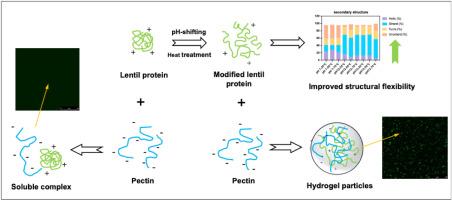小扁豆蛋白的结构修饰促进了果胶和水凝胶颗粒形成的静电复合物
IF 11
1区 农林科学
Q1 CHEMISTRY, APPLIED
引用次数: 0
摘要
蛋白质-多糖相互作用在决定许多食物系统的质地、稳定性和功能方面起着至关重要的作用。然而,植物蛋白通常具有刚性结构,限制了它们与多糖相互作用的能力。本研究探讨了通过ph转移和热处理对扁豆蛋白进行结构修饰如何影响其与果胶形成静电配合物的能力。共聚焦显微镜和粒度分析表明,单独热处理不足以促进复合物的形成。相比之下,pH值的变化(pH 12→7)和75°C的加热处理可以形成均匀的微米级蛋白质-多糖复合物(即水凝胶颗粒)。Zeta电位测量证实了处理后修饰蛋白表面电荷的微小变化,表明观察到的络合作用主要是由结构修饰而不是静电性质的变化驱动的。疏水性和圆二色性分析进一步表明,ph诱导的展开增加了分子柔韧性和增强了蛋白质-多糖相互作用,同时最大限度地减少了不可逆聚集。这些结果表明,对植物蛋白(如扁豆蛋白)进行可控的结构修饰可以改善其功能性能,促进其与多糖形成复合物。这种复合物可以进一步设计成具有可调结构和流变特性的颗粒,使其适合作为脂肪替代品、结构调节剂或各种食品应用中生物活性化合物的输送系统。本文章由计算机程序翻译,如有差异,请以英文原文为准。

Structural modification of lentil protein enhances electrostatic complex formation with pectin and hydrogel particle development
Protein–polysaccharide interactions play a crucial role in determining the texture, stability, and functionality of many food systems. However, plant proteins often possess rigid structures that limit their ability to interact with polysaccharides. This study explored how structural modification of lentil protein, through pH-shifting and heat treatment, influences its capacity to form electrostatic complexes with pectin. Confocal microscopy and particle size analysis showed that heat treatment alone was insufficient to promote complex formation. In contrast, pH-shifting (pH 12 → 7) followed by heating treatment at 75 °C led to the formation of uniform and micron-scale protein–polysaccharide complex (i.e., hydrogel particles). Zeta potential measurements confirmed minimal changes in the surface charge of the modified protein after treatment, indicating that the observed complexation was primarily driven by structural modifications rather than changes in electrostatic properties. Hydrophobicity and circular dichroism analysis further revealed that pH-induced unfolding increased molecular flexibility and enhanced protein–polysaccharide interactions while minimizing irreversible aggregation. These findings demonstrate that controlled structural modification of plant proteins, such as lentil protein, can improve their functional performance and promote the complex formation with polysaccharides. Such complexes can be further engineered into particles with tunable texture and rheological properties, making them suitable as fat replacers, texture modifiers, or delivery systems for bioactive compounds in various food applications.
求助全文
通过发布文献求助,成功后即可免费获取论文全文。
去求助
来源期刊

Food Hydrocolloids
工程技术-食品科技
CiteScore
19.90
自引率
14.00%
发文量
871
审稿时长
37 days
期刊介绍:
Food Hydrocolloids publishes original and innovative research focused on the characterization, functional properties, and applications of hydrocolloid materials used in food products. These hydrocolloids, defined as polysaccharides and proteins of commercial importance, are added to control aspects such as texture, stability, rheology, and sensory properties. The research's primary emphasis should be on the hydrocolloids themselves, with thorough descriptions of their source, nature, and physicochemical characteristics. Manuscripts are expected to clearly outline specific aims and objectives, include a fundamental discussion of research findings at the molecular level, and address the significance of the results. Studies on hydrocolloids in complex formulations should concentrate on their overall properties and mechanisms of action, while simple formulation development studies may not be considered for publication.
The main areas of interest are:
-Chemical and physicochemical characterisation
Thermal properties including glass transitions and conformational changes-
Rheological properties including viscosity, viscoelastic properties and gelation behaviour-
The influence on organoleptic properties-
Interfacial properties including stabilisation of dispersions, emulsions and foams-
Film forming properties with application to edible films and active packaging-
Encapsulation and controlled release of active compounds-
The influence on health including their role as dietary fibre-
Manipulation of hydrocolloid structure and functionality through chemical, biochemical and physical processes-
New hydrocolloids and hydrocolloid sources of commercial potential.
The Journal also publishes Review articles that provide an overview of the latest developments in topics of specific interest to researchers in this field of activity.
 求助内容:
求助内容: 应助结果提醒方式:
应助结果提醒方式:


